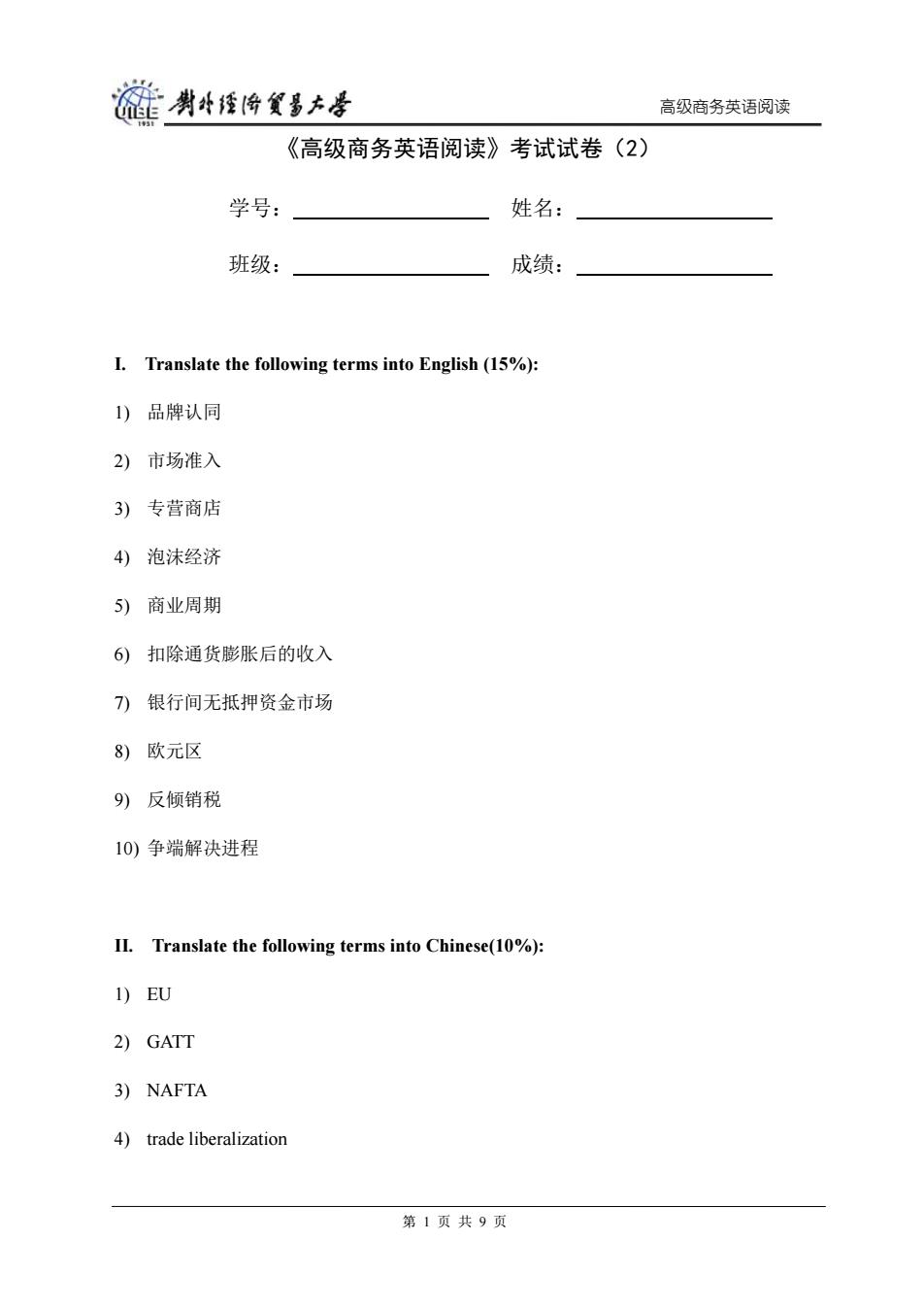
旋剥经降贸多去号 高级商务英语阅读 《高级商务英语阅读》考试试卷(2) 学号: 姓名: 班级: 成绩: I.Translate the following terms into English(15%): )品牌认同 2) 市场准入 3)专营商店 4)泡沫经济 5)商业周期 6)扣除通货膨胀后的收入 7)银行间无抵押资金市场 8)欧元区 9)反倾销税 10)争端解决进程 II.Translate the following terms into Chinese(10%): 1) EU 2)GATT 3)NAFTA 4)trade liberalization 第1页共9页
高级商务英语阅读 《高级商务英语阅读》考试试卷(2) 学号: 姓名: 班级: 成绩: I. Translate the following terms into English (15%): 1) 品牌认同 2) 市场准入 3) 专营商店 4) 泡沫经济 5) 商业周期 6) 扣除通货膨胀后的收入 7) 银行间无抵押资金市场 8) 欧元区 9) 反倾销税 10) 争端解决进程 II. Translate the following terms into Chinese(10%): 1) EU 2) GATT 3) NAFTA 4) trade liberalization 第 1 页 共 9 页
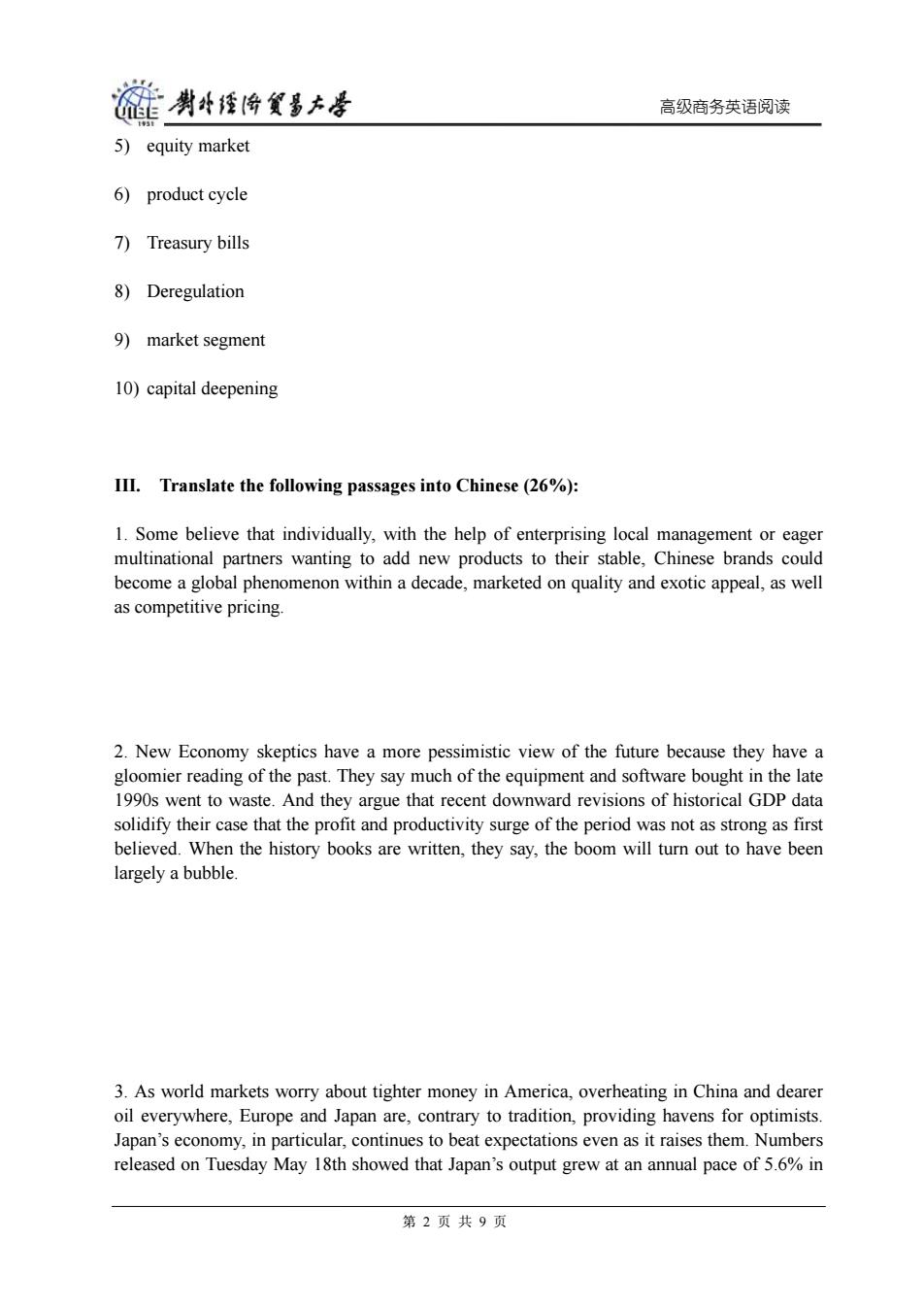
碰费科样降赏多大是 高级商务英语阅读 5)equity market 6)product cycle 7) Treasury bills 8)Deregulation 9)market segment 10)capital deepening III.Translate the following passages into Chinese(26%): 1.Some believe that individually,with the help of enterprising local management or eager multinational partners wanting to add new products to their stable,Chinese brands could become a global phenomenon within a decade,marketed on quality and exotic appeal,as well as competitive pricing. 2.New Economy skeptics have a more pessimistic view of the future because they have a gloomier reading of the past.They say much of the equipment and software bought in the late 1990s went to waste.And they argue that recent downward revisions of historical GDP data solidify their case that the profit and productivity surge of the period was not as strong as first believed.When the history books are written,they say,the boom will turn out to have been largely a bubble. 3.As world markets worry about tighter money in America,overheating in China and dearer oil everywhere,Europe and Japan are,contrary to tradition,providing havens for optimists. Japan's economy,in particular,continues to beat expectations even as it raises them.Numbers released on Tuesday May 18th showed that Japan's output grew at an annual pace of 5.6%in 第2页共9页
高级商务英语阅读 5) equity market 6) product cycle 7) Treasury bills 8) Deregulation 9) market segment 10) capital deepening III. Translate the following passages into Chinese (26%): 1. Some believe that individually, with the help of enterprising local management or eager multinational partners wanting to add new products to their stable, Chinese brands could become a global phenomenon within a decade, marketed on quality and exotic appeal, as well as competitive pricing. 2. New Economy skeptics have a more pessimistic view of the future because they have a gloomier reading of the past. They say much of the equipment and software bought in the late 1990s went to waste. And they argue that recent downward revisions of historical GDP data solidify their case that the profit and productivity surge of the period was not as strong as first believed. When the history books are written, they say, the boom will turn out to have been largely a bubble. 3. As world markets worry about tighter money in America, overheating in China and dearer oil everywhere, Europe and Japan are, contrary to tradition, providing havens for optimists. Japan’s economy, in particular, continues to beat expectations even as it raises them. Numbers released on Tuesday May 18th showed that Japan’s output grew at an annual pace of 5.6% in 第 2 页 共 9 页
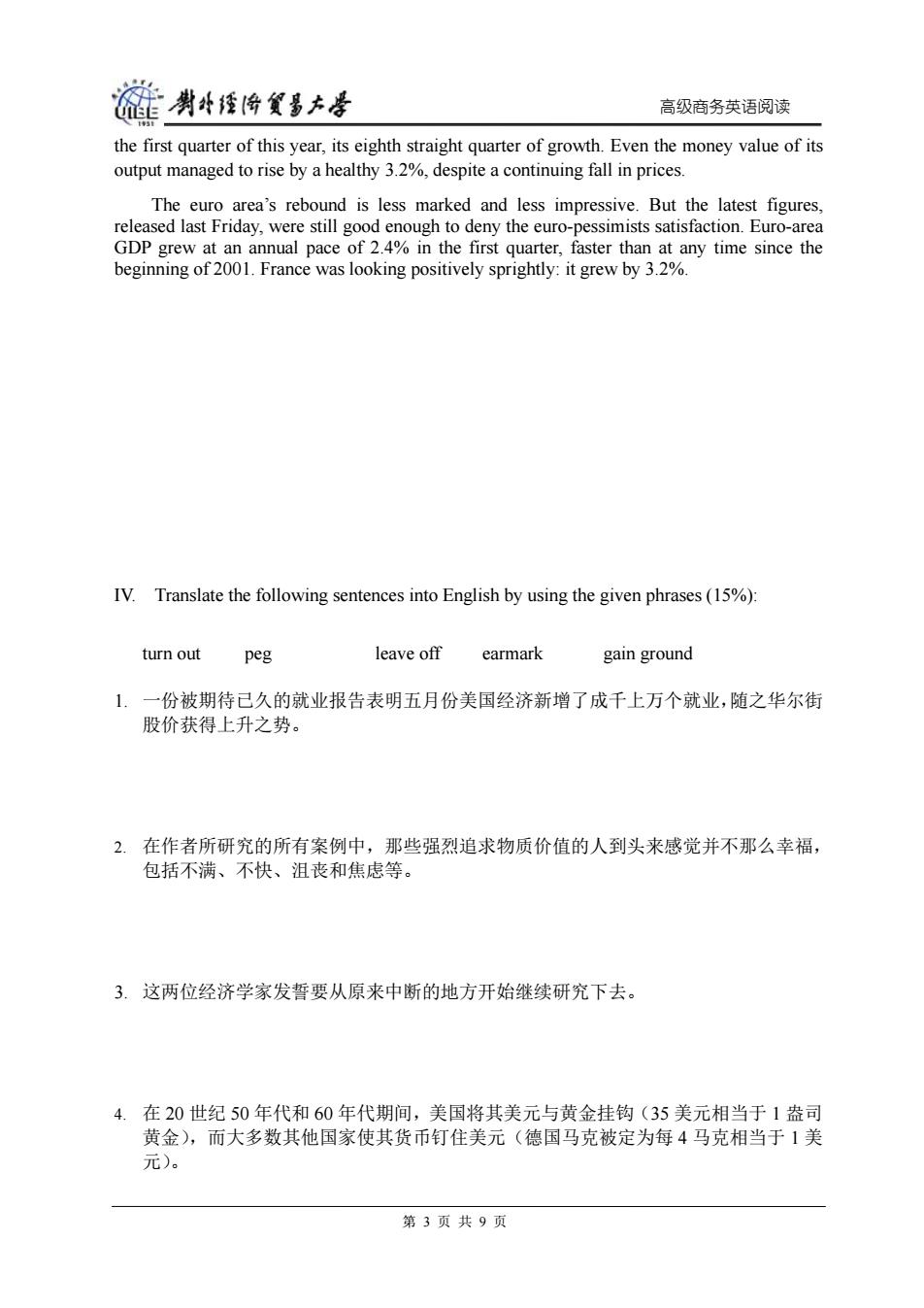
链勇华经将食多大是 高级商务英语阅读 the first quarter of this year,its eighth straight quarter of growth.Even the money value of its output managed to rise by a healthy 3.2%,despite a continuing fall in prices. The euro area's rebound is less marked and less impressive.But the latest figures, released last Friday,were still good enough to deny the euro-pessimists satisfaction.Euro-area GDP grew at an annual pace of 2.4%in the first quarter,faster than at any time since the beginning of 2001.France was looking positively sprightly:it grew by 3.2%. IV.Translate the following sentences into English by using the given phrases(15%): turn out peg leave off earmark gain ground 1.一份被期待已久的就业报告表明五月份美国经济新增了成千上万个就业,随之华尔街 股价获得上升之势。 2.在作者所研究的所有案例中,那些强烈追求物质价值的人到头来感觉并不那么幸福, 包括不满、不快、沮丧和焦虑等。 3.这两位经济学家发誓要从原来中断的地方开始继续研究下去。 4.在20世纪50年代和60年代期间,美国将其美元与黄金挂钩(35美元相当于1盎司 黄金),而大多数其他国家使其货币钉住美元(德国马克被定为每4马克相当于1美 元)。 第3页共9页
高级商务英语阅读 the first quarter of this year, its eighth straight quarter of growth. Even the money value of its output managed to rise by a healthy 3.2%, despite a continuing fall in prices. The euro area’s rebound is less marked and less impressive. But the latest figures, released last Friday, were still good enough to deny the euro-pessimists satisfaction. Euro-area GDP grew at an annual pace of 2.4% in the first quarter, faster than at any time since the beginning of 2001. France was looking positively sprightly: it grew by 3.2%. IV. Translate the following sentences into English by using the given phrases (15%): turn out peg leave off earmark gain ground 1. 一份被期待已久的就业报告表明五月份美国经济新增了成千上万个就业,随之华尔街 股价获得上升之势。 2. 在作者所研究的所有案例中,那些强烈追求物质价值的人到头来感觉并不那么幸福, 包括不满、不快、沮丧和焦虑等。 3. 这两位经济学家发誓要从原来中断的地方开始继续研究下去。 4. 在 20 世纪 50 年代和 60 年代期间,美国将其美元与黄金挂钩(35 美元相当于 1 盎司 黄金),而大多数其他国家使其货币钉住美元(德国马克被定为每 4 马克相当于 1 美 元)。 第 3 页 共 9 页
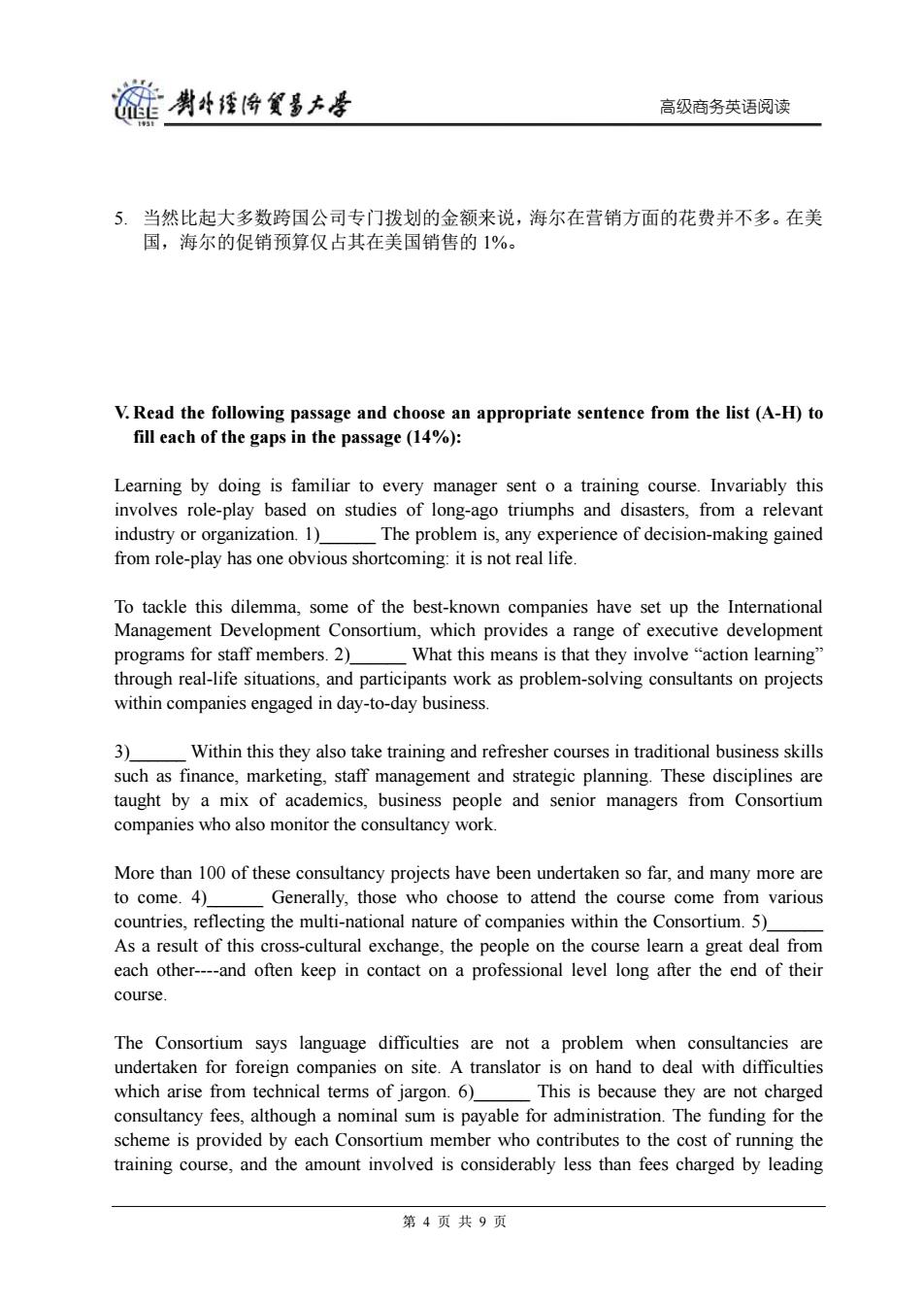
链典4矮降贸多大 高级商务英语阅读 5.当然比起大多数跨国公司专门拨划的金额来说,海尔在营销方面的花费并不多。在美 国,海尔的促销预算仅占其在美国销售的1%。 V.Read the following passage and choose an appropriate sentence from the list(A-H)to fill each of the gaps in the passage (14%): Learning by doing is familiar to every manager sent o a training course.Invariably this involves role-play based on studies of long-ago triumphs and disasters,from a relevant industry or organization.1)The problem is,any experience of decision-making gained from role-play has one obvious shortcoming:it is not real life. To tackle this dilemma,some of the best-known companies have set up the International Management Development Consortium,which provides a range of executive development programs for staff members.2)What this means is that they involve "action learning" through real-life situations,and participants work as problem-solving consultants on projects within companies engaged in day-to-day business. 3) Within this they also take training and refresher courses in traditional business skills such as finance,marketing,staff management and strategic planning.These disciplines are taught by a mix of academics,business people and senior managers from Consortium companies who also monitor the consultancy work. More than 100 of these consultancy projects have been undertaken so far,and many more are to come.4)Generally,those who choose to attend the course come from various countries,reflecting the multi-national nature of companies within the Consortium.5) As a result of this cross-cultural exchange,the people on the course learn a great deal from each other----and often keep in contact on a professional level long after the end of their course. The Consortium says language difficulties are not a problem when consultancies are undertaken for foreign companies on site.A translator is on hand to deal with difficulties which arise from technical terms of jargon.6)This is because they are not charged consultancy fees,although a nominal sum is payable for administration.The funding for the scheme is provided by each Consortium member who contributes to the cost of running the training course,and the amount involved is considerably less than fees charged by leading 第4页共9页
高级商务英语阅读 5. 当然比起大多数跨国公司专门拨划的金额来说,海尔在营销方面的花费并不多。在美 国,海尔的促销预算仅占其在美国销售的 1%。 V. Read the following passage and choose an appropriate sentence from the list (A-H) to fill each of the gaps in the passage (14%): Learning by doing is familiar to every manager sent o a training course. Invariably this involves role-play based on studies of long-ago triumphs and disasters, from a relevant industry or organization. 1)______ The problem is, any experience of decision-making gained from role-play has one obvious shortcoming: it is not real life. To tackle this dilemma, some of the best-known companies have set up the International Management Development Consortium, which provides a range of executive development programs for staff members. 2)______ What this means is that they involve “action learning” through real-life situations, and participants work as problem-solving consultants on projects within companies engaged in day-to-day business. 3)______ Within this they also take training and refresher courses in traditional business skills such as finance, marketing, staff management and strategic planning. These disciplines are taught by a mix of academics, business people and senior managers from Consortium companies who also monitor the consultancy work. More than 100 of these consultancy projects have been undertaken so far, and many more are to come. 4)______ Generally, those who choose to attend the course come from various countries, reflecting the multi-national nature of companies within the Consortium. 5)______ As a result of this cross-cultural exchange, the people on the course learn a great deal from each other----and often keep in contact on a professional level long after the end of their course. The Consortium says language difficulties are not a problem when consultancies are undertaken for foreign companies on site. A translator is on hand to deal with difficulties which arise from technical terms of jargon. 6)______ This is because they are not charged consultancy fees, although a nominal sum is payable for administration. The funding for the scheme is provided by each Consortium member who contributes to the cost of running the training course, and the amount involved is considerably less than fees charged by leading 第 4 页 共 9 页
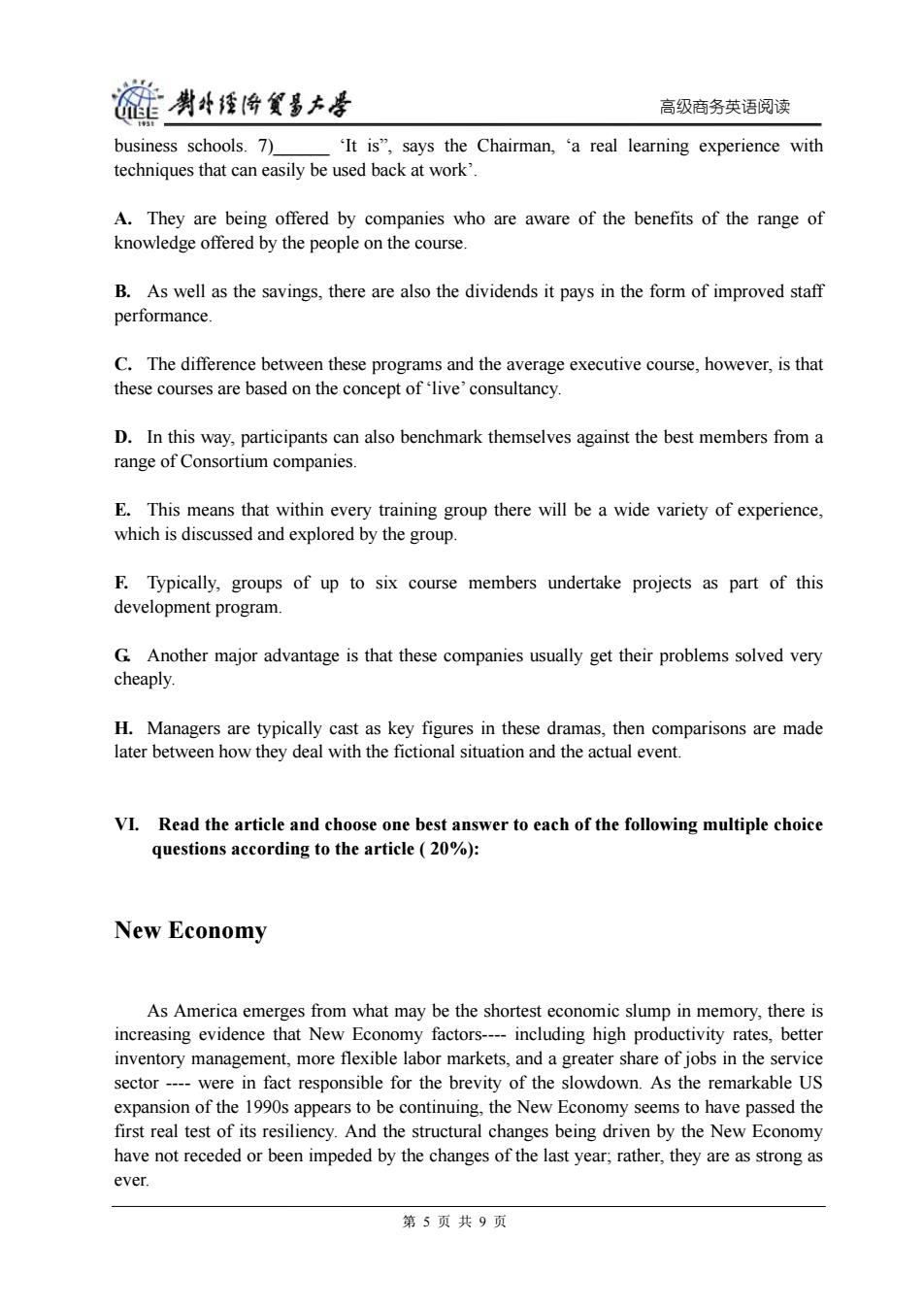
碰男华经海贸多大学 高级商务英语阅读 business schools.7) 'It is",says the Chairman,'a real learning experience with techniques that can easily be used back at work' A.They are being offered by companies who are aware of the benefits of the range of knowledge offered by the people on the course. B.As well as the savings,there are also the dividends it pays in the form of improved staff performance. C.The difference between these programs and the average executive course,however,is that these courses are based on the concept of 'live'consultancy. D.In this way,participants can also benchmark themselves against the best members from a range of Consortium companies. E.This means that within every training group there will be a wide variety of experience, which is discussed and explored by the group. F.Typically,groups of up to six course members undertake projects as part of this development program. G Another major advantage is that these companies usually get their problems solved very cheaply. H.Managers are typically cast as key figures in these dramas,then comparisons are made later between how they deal with the fictional situation and the actual event. VI.Read the article and choose one best answer to each of the following multiple choice questions according to the article (20%): New Economy As America emerges from what may be the shortest economic slump in memory,there is increasing evidence that New Economy factors----including high productivity rates,better inventory management,more flexible labor markets,and a greater share of jobs in the service sector----were in fact responsible for the brevity of the slowdown.As the remarkable US expansion of the 1990s appears to be continuing,the New Economy seems to have passed the first real test of its resiliency.And the structural changes being driven by the New Economy have not receded or been impeded by the changes of the last year;rather,they are as strong as ever. 第5页共9页
高级商务英语阅读 business schools. 7)______ ‘It is”, says the Chairman, ‘a real learning experience with techniques that can easily be used back at work’. A. They are being offered by companies who are aware of the benefits of the range of knowledge offered by the people on the course. B. As well as the savings, there are also the dividends it pays in the form of improved staff performance. C. The difference between these programs and the average executive course, however, is that these courses are based on the concept of ‘live’ consultancy. D. In this way, participants can also benchmark themselves against the best members from a range of Consortium companies. E. This means that within every training group there will be a wide variety of experience, which is discussed and explored by the group. F. Typically, groups of up to six course members undertake projects as part of this development program. G. Another major advantage is that these companies usually get their problems solved very cheaply. H. Managers are typically cast as key figures in these dramas, then comparisons are made later between how they deal with the fictional situation and the actual event. VI. Read the article and choose one best answer to each of the following multiple choice questions according to the article ( 20%): New Economy As America emerges from what may be the shortest economic slump in memory, there is increasing evidence that New Economy factors---- including high productivity rates, better inventory management, more flexible labor markets, and a greater share of jobs in the service sector ---- were in fact responsible for the brevity of the slowdown. As the remarkable US expansion of the 1990s appears to be continuing, the New Economy seems to have passed the first real test of its resiliency. And the structural changes being driven by the New Economy have not receded or been impeded by the changes of the last year; rather, they are as strong as ever. 第 5 页 共 9 页
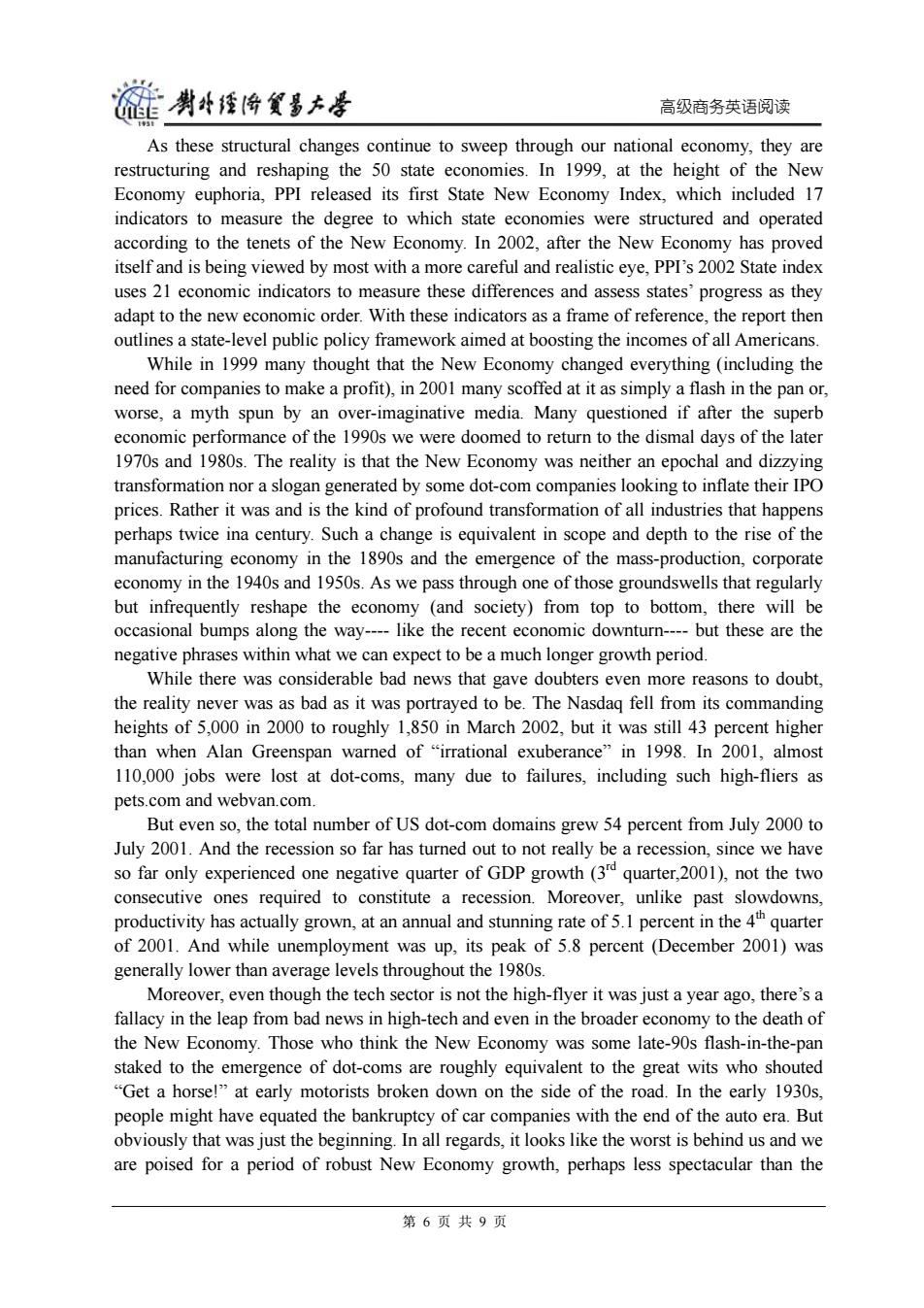
链喇4煙哈餐多方孝 高级商务英语阅读 As these structural changes continue to sweep through our national economy,they are restructuring and reshaping the 50 state economies.In 1999,at the height of the New Economy euphoria,PPI released its first State New Economy Index,which included 17 indicators to measure the degree to which state economies were structured and operated according to the tenets of the New Economy.In 2002,after the New Economy has proved itself and is being viewed by most with a more careful and realistic eye,PPI's 2002 State index uses 21 economic indicators to measure these differences and assess states'progress as they adapt to the new economic order.With these indicators as a frame of reference,the report then outlines a state-level public policy framework aimed at boosting the incomes of all Americans. While in 1999 many thought that the New Economy changed everything (including the need for companies to make a profit),in 2001 many scoffed at it as simply a flash in the pan or, worse,a myth spun by an over-imaginative media.Many questioned if after the superb economic performance of the 1990s we were doomed to return to the dismal days of the later 1970s and 1980s.The reality is that the New Economy was neither an epochal and dizzying transformation nor a slogan generated by some dot-com companies looking to inflate their IPO prices.Rather it was and is the kind of profound transformation of all industries that happens perhaps twice ina century.Such a change is equivalent in scope and depth to the rise of the manufacturing economy in the 1890s and the emergence of the mass-production,corporate economy in the 1940s and 1950s.As we pass through one of those groundswells that regularly but infrequently reshape the economy (and society)from top to bottom,there will be occasional bumps along the way----like the recent economic downturn----but these are the negative phrases within what we can expect to be a much longer growth period. While there was considerable bad news that gave doubters even more reasons to doubt, the reality never was as bad as it was portrayed to be.The Nasdaq fell from its commanding heights of 5,000 in 2000 to roughly 1,850 in March 2002,but it was still 43 percent higher than when Alan Greenspan warned of "irrational exuberance"in 1998.In 2001,almost 110,000 jobs were lost at dot-coms,many due to failures,including such high-fliers as pets.com and webvan.com. But even so,the total number of US dot-com domains grew 54 percent from July 2000 to July 2001.And the recession so far has turned out to not really be a recession,since we have so far only experienced one negative quarter of GDP growth (3d quarter,2001),not the two consecutive ones required to constitute a recession.Moreover,unlike past slowdowns, productivity has actually grown,at an annual and stunning rate of 5.1 percent in the 4h quarter of 2001.And while unemployment was up,its peak of 5.8 percent (December 2001)was generally lower than average levels throughout the 1980s. Moreover,even though the tech sector is not the high-flyer it was just a year ago,there's a fallacy in the leap from bad news in high-tech and even in the broader economy to the death of the New Economy.Those who think the New Economy was some late-90s flash-in-the-pan staked to the emergence of dot-coms are roughly equivalent to the great wits who shouted "Get a horse!"at early motorists broken down on the side of the road.In the early 1930s, people might have equated the bankruptcy of car companies with the end of the auto era.But obviously that was just the beginning.In all regards,it looks like the worst is behind us and we are poised for a period of robust New Economy growth,perhaps less spectacular than the 第6页共9页
高级商务英语阅读 As these structural changes continue to sweep through our national economy, they are restructuring and reshaping the 50 state economies. In 1999, at the height of the New Economy euphoria, PPI released its first State New Economy Index, which included 17 indicators to measure the degree to which state economies were structured and operated according to the tenets of the New Economy. In 2002, after the New Economy has proved itself and is being viewed by most with a more careful and realistic eye, PPI’s 2002 State index uses 21 economic indicators to measure these differences and assess states’ progress as they adapt to the new economic order. With these indicators as a frame of reference, the report then outlines a state-level public policy framework aimed at boosting the incomes of all Americans. While in 1999 many thought that the New Economy changed everything (including the need for companies to make a profit), in 2001 many scoffed at it as simply a flash in the pan or, worse, a myth spun by an over-imaginative media. Many questioned if after the superb economic performance of the 1990s we were doomed to return to the dismal days of the later 1970s and 1980s. The reality is that the New Economy was neither an epochal and dizzying transformation nor a slogan generated by some dot-com companies looking to inflate their IPO prices. Rather it was and is the kind of profound transformation of all industries that happens perhaps twice ina century. Such a change is equivalent in scope and depth to the rise of the manufacturing economy in the 1890s and the emergence of the mass-production, corporate economy in the 1940s and 1950s. As we pass through one of those groundswells that regularly but infrequently reshape the economy (and society) from top to bottom, there will be occasional bumps along the way---- like the recent economic downturn---- but these are the negative phrases within what we can expect to be a much longer growth period. While there was considerable bad news that gave doubters even more reasons to doubt, the reality never was as bad as it was portrayed to be. The Nasdaq fell from its commanding heights of 5,000 in 2000 to roughly 1,850 in March 2002, but it was still 43 percent higher than when Alan Greenspan warned of “irrational exuberance” in 1998. In 2001, almost 110,000 jobs were lost at dot-coms, many due to failures, including such high-fliers as pets.com and webvan.com. But even so, the total number of US dot-com domains grew 54 percent from July 2000 to July 2001. And the recession so far has turned out to not really be a recession, since we have so far only experienced one negative quarter of GDP growth (3rd quarter,2001), not the two consecutive ones required to constitute a recession. Moreover, unlike past slowdowns, productivity has actually grown, at an annual and stunning rate of 5.1 percent in the 4th quarter of 2001. And while unemployment was up, its peak of 5.8 percent (December 2001) was generally lower than average levels throughout the 1980s. Moreover, even though the tech sector is not the high-flyer it was just a year ago, there’s a fallacy in the leap from bad news in high-tech and even in the broader economy to the death of the New Economy. Those who think the New Economy was some late-90s flash-in-the-pan staked to the emergence of dot-coms are roughly equivalent to the great wits who shouted “Get a horse!” at early motorists broken down on the side of the road. In the early 1930s, people might have equated the bankruptcy of car companies with the end of the auto era. But obviously that was just the beginning. In all regards, it looks like the worst is behind us and we are poised for a period of robust New Economy growth, perhaps less spectacular than the 第 6 页 共 9 页

链男母经降贸多大量 高级商务英语阅读 dizzying days of 2000,but strong all the same.It's clear that this was more than a one-time burst of energy that has dissipated.Rather,we've barely scratched the surface of New Economy digital transformation.To paraphrase Mark Twin,reports of the New Economy's demise have been greatly exaggerated. Broadband Internet connections continue to grow by more th 50 percent a year.Venture capitalists invested more in 2001 than in any year prior to 1999 and more than they did in the years 1990 to 1996 combined.Corporate R&D as a share of GDP reached an all-time high in 2000.E-commerce retail sales in the last year grew 2.5 time faster than total retail sales. Business investments in formation technology fell relative to 2000 levels,but were 15 percent higher than 1999 levels.And a host of new technologies,including voice recognition,expert systems,smart cards,e-books,cheap storage devices,new display devices and video software, intelligent transportation systems,"third generation"wireless communication devices,and robots,are poised to be commercialized. But even though the IT revolution is still only in its adolescence and exciting times are ahead,we need to remember that the New Economy was never just about the Internet and what investors Jim Clark and writer Michael Lewis dubbed the"next new thing." Rather,the New Economy is about the transformation of all industries and the overall economy.As such,the New Economy represents a complex array of forces.These include the reorganization of firms,more efficient and dynamic capital markets,more economic "churning"and entrepreneurial dynamism,relentless globalization,continuing economic competition,and increasingly volatile labor markets.And there is every reason to believe that these forces that produced a turnaround in productivity and wage growth in the last half of the 1990s will continue to produce equally strong growth in the first decade of the 2000s.As a result,there are a number of new economic realities that states need to contend with. First,new industries,especially traded services and E-businesses,are becoming a more important share of the economic base of regions.As manufacturers continue to dramatically boost productivity,factory jobs continue to decline as a share of total employment while jobs in services grow.For example,Navistar's Indianapolis engine plant spent $285 million in new investments between 1995 and 2000 with the result that while it took 900 people to produce 175 engines a day in 1994,the same 900 workers produce 1,400 today.As a result of efforts by Navistar and the nation's other 360,000 manufacturing firms,manufacturing jobs now account for just 13.4 percent of employment.Even in traditionally manufacturing-oriented states like Michigan and North Carolina,manufacturing employment is only 19.8 percent and 18.2 percent of all jobs,respectively.This is not to say that manufacturing is not important;it's usually the economic base sector that brings in money from outside the region that in turn supports local-serving businesses (e.g.dry cleaners).But it does mean that states that look to growing sectors,many of which will be outside of manufacturing,will be the ones that succeed. Second,most industries and firms,even "traditional ones",are organizing work around technology.While the "high-tech"firms focus on developing new technologies,all of them must be using advanced technology to be successful.For example,manufacturers who use more technologies (e.g.computer-aided design)in their production processes pay higher wages,export more,and are more productive than manufacturers who do not.States whose 第7页共9页
高级商务英语阅读 dizzying days of 2000, but strong all the same. It’s clear that this was more than a one-time burst of energy that has dissipated. Rather, we’ve barely scratched the surface of New Economy digital transformation. To paraphrase Mark Twin, reports of the New Economy’s demise have been greatly exaggerated. Broadband Internet connections continue to grow by more th 50 percent a year. Venture capitalists invested more in 2001 than in any year prior to 1999 and more than they did in the years 1990 to 1996 combined. Corporate R&D as a share of GDP reached an all-time high in 2000. E-commerce retail sales in the last year grew 2.5 time faster than total retail sales. Business investments in formation technology fell relative to 2000 levels, but were 15 percent higher than 1999 levels. And a host of new technologies, including voice recognition, expert systems, smart cards, e-books, cheap storage devices, new display devices and video software, intelligent transportation systems, “third generation” wireless communication devices, and robots, are poised to be commercialized. But even though the IT revolution is still only in its adolescence and exciting times are ahead, we need to remember that the New Economy was never just about the Internet and what investors Jim Clark and writer Michael Lewis dubbed the “next new thing.” Rather, the New Economy is about the transformation of all industries and the overall economy. As such, the New Economy represents a complex array of forces. These include the reorganization of firms, more efficient and dynamic capital markets, more economic “churning” and entrepreneurial dynamism, relentless globalization, continuing economic competition, and increasingly volatile labor markets. And there is every reason to believe that these forces that produced a turnaround in productivity and wage growth in the last half of the 1990s will continue to produce equally strong growth in the first decade of the 2000s. As a result, there are a number of new economic realities that states need to contend with. First, new industries, especially traded services and E-businesses, are becoming a more important share of the economic base of regions. As manufacturers continue to dramatically boost productivity, factory jobs continue to decline as a share of total employment while jobs in services grow. For example, Navistar’s Indianapolis engine plant spent $285 million in new investments between 1995 and 2000 with the result that while it took 900 people to produce 175 engines a day in 1994, the same 900 workers produce 1,400 today. As a result of efforts by Navistar and the nation’s other 360,000 manufacturing firms, manufacturing jobs now account for just 13.4 percent of employment. Even in traditionally manufacturing-oriented states like Michigan and North Carolina, manufacturing employment is only 19.8 percent and 18.2 percent of all jobs, respectively. This is not to say that manufacturing is not important; it’s usually the economic base sector that brings in money from outside the region that in turn supports local-serving businesses (e.g. dry cleaners). But it does mean that states that look to growing sectors, many of which will be outside of manufacturing, will be the ones that succeed. Second, most industries and firms, even “traditional ones”, are organizing work around technology. While the “high-tech” firms focus on developing new technologies, all of them must be using advanced technology to be successful. For example, manufacturers who use more technologies (e.g. computer-aided design) in their production processes pay higher wages, export more, and are more productive than manufacturers who do not. States whose 第 7 页 共 9 页
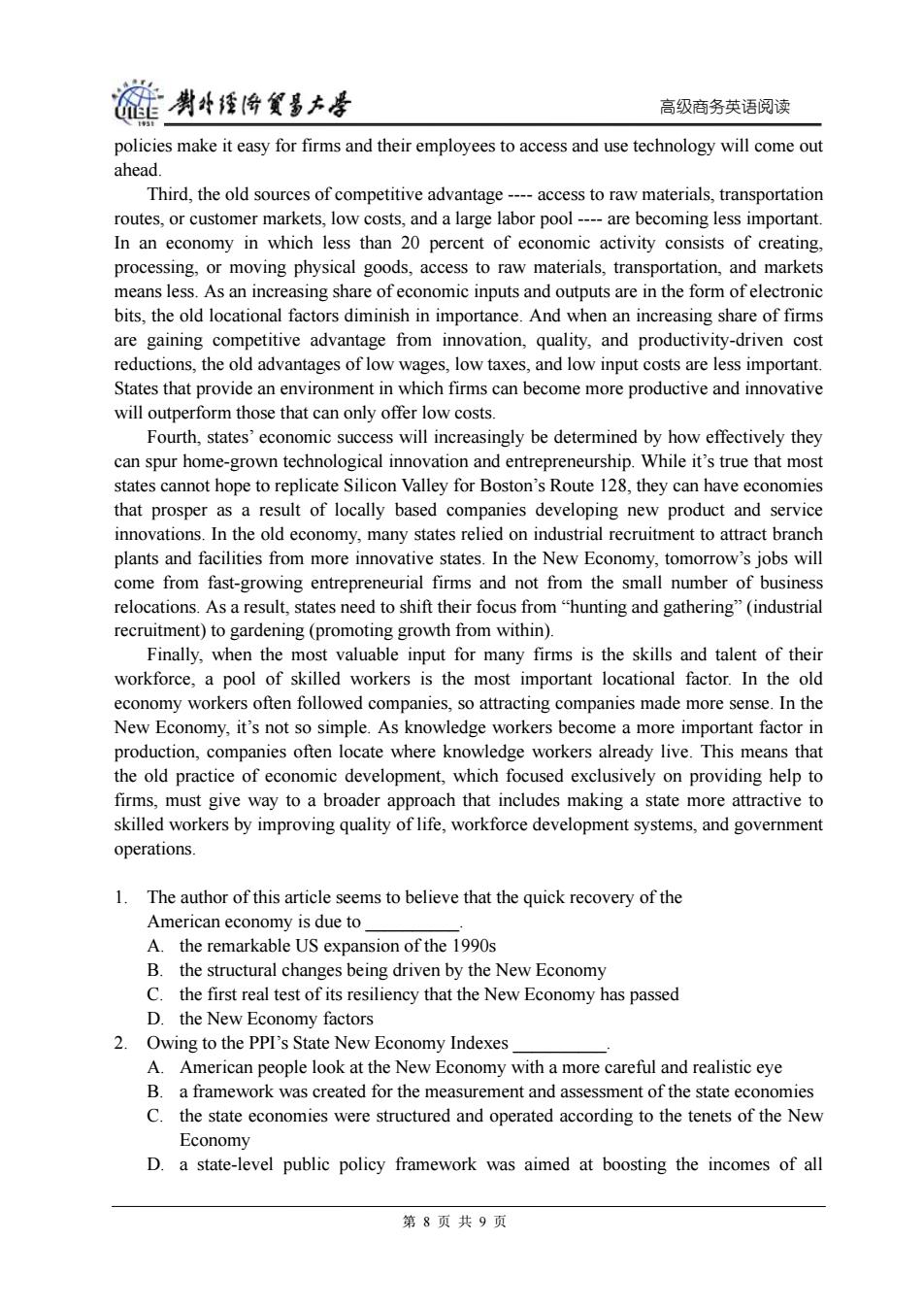
碰男华经海贸多大学 高级商务英语阅读 policies make it easy for firms and their employees to access and use technology will come out ahead. Third,the old sources of competitive advantage----access to raw materials,transportation routes,or customer markets,low costs,and a large labor pool----are becoming less important. In an economy in which less than 20 percent of economic activity consists of creating, processing,or moving physical goods,access to raw materials,transportation,and markets means less.As an increasing share of economic inputs and outputs are in the form of electronic bits,the old locational factors diminish in importance.And when an increasing share of firms are gaining competitive advantage from innovation,quality,and productivity-driven cost reductions,the old advantages of low wages,low taxes,and low input costs are less important. States that provide an environment in which firms can become more productive and innovative will outperform those that can only offer low costs. Fourth,states'economic success will increasingly be determined by how effectively they can spur home-grown technological innovation and entrepreneurship.While it's true that most states cannot hope to replicate Silicon Valley for Boston's Route 128,they can have economies that prosper as a result of locally based companies developing new product and service innovations.In the old economy,many states relied on industrial recruitment to attract branch plants and facilities from more innovative states.In the New Economy,tomorrow's jobs will come from fast-growing entrepreneurial firms and not from the small number of business relocations.As a result,states need to shift their focus from"hunting and gathering"(industrial recruitment)to gardening(promoting growth from within). Finally,when the most valuable input for many firms is the skills and talent of their workforce,a pool of skilled workers is the most important locational factor.In the old economy workers often followed companies,so attracting companies made more sense.In the New Economy,it's not so simple.As knowledge workers become a more important factor in production,companies often locate where knowledge workers already live.This means that the old practice of economic development,which focused exclusively on providing help to firms,must give way to a broader approach that includes making a state more attractive to skilled workers by improving quality of life,workforce development systems,and government operations. 1.The author of this article seems to believe that the quick recovery of the American economy is due to A.the remarkable US expansion of the 1990s B.the structural changes being driven by the New Economy C.the first real test of its resiliency that the New Economy has passed D.the New Economy factors 2.Owing to the PPI's State New Economy Indexes A.American people look at the New Economy with a more careful and realistic eye B.a framework was created for the measurement and assessment of the state economies C. the state economies were structured and operated according to the tenets of the New Economy D.a state-level public policy framework was aimed at boosting the incomes of all 第8页共9页
高级商务英语阅读 policies make it easy for firms and their employees to access and use technology will come out ahead. Third, the old sources of competitive advantage ---- access to raw materials, transportation routes, or customer markets, low costs, and a large labor pool ---- are becoming less important. In an economy in which less than 20 percent of economic activity consists of creating, processing, or moving physical goods, access to raw materials, transportation, and markets means less. As an increasing share of economic inputs and outputs are in the form of electronic bits, the old locational factors diminish in importance. And when an increasing share of firms are gaining competitive advantage from innovation, quality, and productivity-driven cost reductions, the old advantages of low wages, low taxes, and low input costs are less important. States that provide an environment in which firms can become more productive and innovative will outperform those that can only offer low costs. Fourth, states’ economic success will increasingly be determined by how effectively they can spur home-grown technological innovation and entrepreneurship. While it’s true that most states cannot hope to replicate Silicon Valley for Boston’s Route 128, they can have economies that prosper as a result of locally based companies developing new product and service innovations. In the old economy, many states relied on industrial recruitment to attract branch plants and facilities from more innovative states. In the New Economy, tomorrow’s jobs will come from fast-growing entrepreneurial firms and not from the small number of business relocations. As a result, states need to shift their focus from “hunting and gathering” (industrial recruitment) to gardening (promoting growth from within). Finally, when the most valuable input for many firms is the skills and talent of their workforce, a pool of skilled workers is the most important locational factor. In the old economy workers often followed companies, so attracting companies made more sense. In the New Economy, it’s not so simple. As knowledge workers become a more important factor in production, companies often locate where knowledge workers already live. This means that the old practice of economic development, which focused exclusively on providing help to firms, must give way to a broader approach that includes making a state more attractive to skilled workers by improving quality of life, workforce development systems, and government operations. 1. The author of this article seems to believe that the quick recovery of the American economy is due to __________. A. the remarkable US expansion of the 1990s B. the structural changes being driven by the New Economy C. the first real test of its resiliency that the New Economy has passed D. the New Economy factors 2. Owing to the PPI’s State New Economy Indexes __________. A. American people look at the New Economy with a more careful and realistic eye B. a framework was created for the measurement and assessment of the state economies C. the state economies were structured and operated according to the tenets of the New Economy D. a state-level public policy framework was aimed at boosting the incomes of all 第 8 页 共 9 页

莲剥4将发多大号 高级商务英语阅读 Americans 3.Which of the following statements is not true according to the author? A.The Nasdaq in 2002 fell by 75%compared with that in 2000. B.The Nasdaq in 1996 was roughly 1294. C.About one hundred and ten thousand jobs were lost at dot-coms in 2001 D.The number of US dot-com domains increased during 2000-2001. 4.By saying"we've barely scratched the surface of New Economy digital transformation",the author probably meant that A.a period of robust New Economy growth was about to come B.the New Economy's demise had been greatly exaggerated C.the great potential of the New Economy was yet to be released D.the New Economy was some late-90s flash-in-the-pan staked to the emergence of dot-coms 5.The author of this article made a list of achievements(Broadband Internet connections continue to grow by more than 50 percent a year,etc)show that A.commercialization is inevitable B.the New Economy is far from being over C.the prime time for IT revolution has come D.the Internet is a feat unmatched at any time in history 6.According to the article,the complex array of forces represented by the New Economy refers to A.the reorganization of firms and more efficient and dynamic capital markets B.more economic "churning"and entrepreneurial dynamism C.globalization,economic competition,and volatile labor markets D.all of the above 7.The fundamental reason for the emergence and growing importance of trade services and E-businesses is that A.manufacturing is not as important as it used to be B.there has been a considerable increase of productivity over the years C.fewer people are needed in factories D.many states that look to growing sectors are now outside of manufacturing 8.It can be inferred from the article that the author's attitude towards the New Economy is A.negative B.objective C.subjective D.positive 第9页共9页
高级商务英语阅读 Americans 3. Which of the following statements is not true according to the author? A. The Nasdaq in 2002 fell by 75% compared with that in 2000. B. The Nasdaq in 1996 was roughly 1294. C. About one hundred and ten thousand jobs were lost at dot-coms in 2001. D. The number of US dot-com domains increased during 2000-2001. 4. By saying “we’ve barely scratched the surface of New Economy digital transformation”, the author probably meant that __________. A. a period of robust New Economy growth was about to come B. the New Economy’s demise had been greatly exaggerated C. the great potential of the New Economy was yet to be released D. the New Economy was some late-90s flash-in-the-pan staked to the emergence of dot-coms 5. The author of this article made a list of achievements (Broadband Internet connections continue to grow by more than 50 percent a year, etc) show that __________. A. commercialization is inevitable B. the New Economy is far from being over C. the prime time for IT revolution has come D. the Internet is a feat unmatched at any time in history 6. According to the article, the complex array of forces represented by the New Economy refers to __________. A. the reorganization of firms and more efficient and dynamic capital markets B. more economic “churning” and entrepreneurial dynamism C. globalization, economic competition, and volatile labor markets D. all of the above 7. The fundamental reason for the emergence and growing importance of trade services and E-businesses is that __________. A. manufacturing is not as important as it used to be B. there has been a considerable increase of productivity over the years C. fewer people are needed in factories D. many states that look to growing sectors are now outside of manufacturing 8. It can be inferred from the article that the author’s attitude towards the New Economy is __________. A. negative B. objective C. subjective D. positive 第 9 页 共 9 页